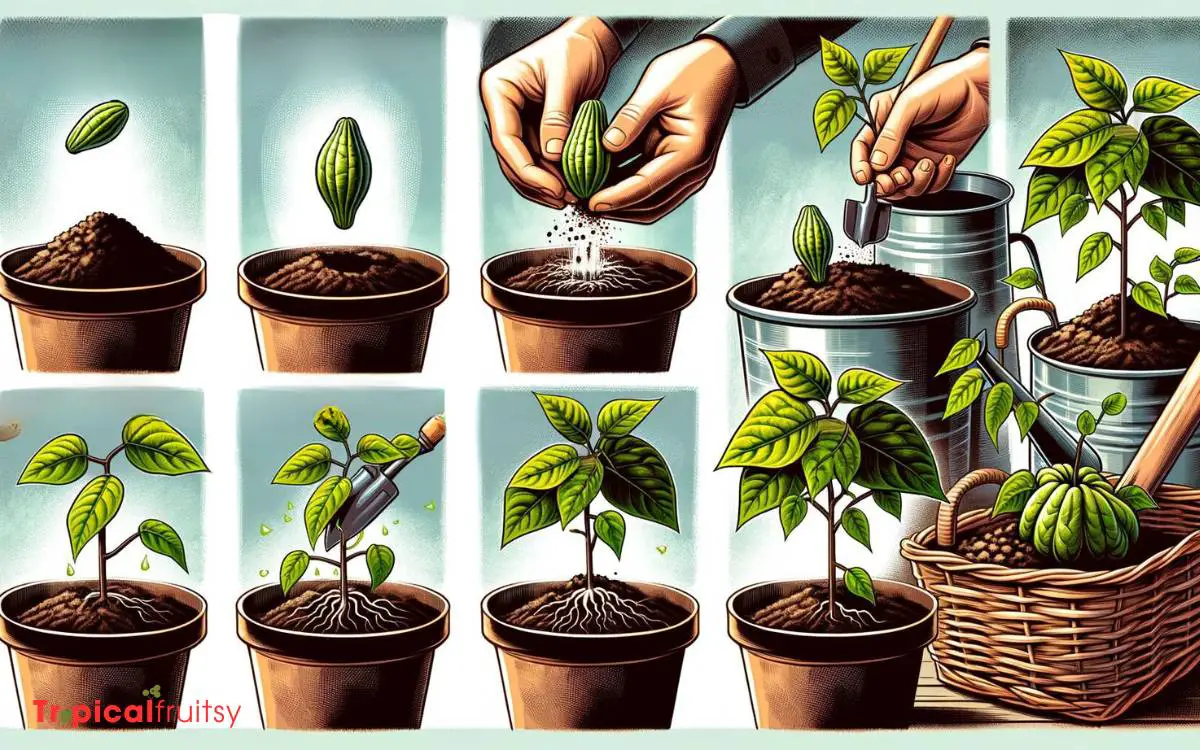How to Grow Chayote from Seed? 5 Easy Steps!
To grow chayote from seed, you need to start with a whole, mature chayote fruit from the grocery store or a farmers’ market. Place the fruit in a warm, sunny location and wait for it to sprout, which can take several weeks.
Once the sprout is a few inches long, plant the chayote in a pot with well-draining soil, with the sprout pointing upwards.
Keep the soil consistently moist and provide plenty of sunlight. When the plant is vigorous enough and all danger of frost has passed, transplant it to a location in your garden where it has room to spread or climb.
Chayote (Sechium edule), also known as vegetable pear, is a warm-climate perennial vine that produces edible fruit.
Growing chayote from seed is a unique process because the seed is not removed from the fruit before planting. Instead, the whole fruit is used.
Here are some key points to remember when growing chayote:
Unlock the potential of your garden by planting a chayote vine; not only will it yield delicious fruits, but it will also add a lush, tropical flair to your outdoor space.

Key Takeaway
Step 1: Selecting the Right Chayote
Let’s choose a mature, healthy chayote fruit as our seed source to ensure robust plant growth.
Selecting the right chayote is crucial; we’re looking for one with a smooth, firm skin free of blemishes and soft spots. The ideal candidate boasts a deep green hue, indicating its freshness and vitality.
It’s essential to understand that chayote fruits contain a single, large seed that we can’t remove; instead, the entire fruit functions as the seed.
We’ll need to store the chayote in a well-ventilated space at room temperature until it begins to sprout. This sprouting indicates that the seed is viable and ready to plant.
Step 2: Preparing for Germination
After selecting the right chayote, we’ll need to focus on properly preparing it for germination. The process begins by ensuring the chayote fruit is mature, characterized by a hard outer skin. We’ll store it at room temperature until a sprout emerges.
This sprout is actually a shoot from the seed within the chayote, which means it’s ready for the next step.
We must prepare a well-draining soil mix, typically composed of equal parts of potting soil, compost, and perlite. This combination promotes aeration and moisture retention, vital for the seedling’s development.
The chayote should be planted in a container with the sprout facing upwards, allowing the shoot to grow vertically while the root system establishes itself below. Adequate sunlight and consistent moisture are crucial during this stage.
Step 3: Planting Your Chayote Seed
We’ll begin by placing the chayote in the center of the pot, with the sprout pointing upward to ensure proper growth orientation. It’s crucial to mimic the natural conditions for optimal development.
Here are the steps we’ll follow:
- Fill a pot with well-draining soil, enriched with organic compost to provide the necessary nutrients.
- Bury the seed halfway into the soil, ensuring that the top half, where the sprout emerges, is exposed to air and light.
- Water the soil gently but thoroughly to moisten it without causing the seed to rot.
- Place the pot in a warm location with indirect sunlight to promote photosynthesis without exposing the tender sprout to harsh conditions.
Step 4: Caring for the Growing Vine
Once the chayote’s vine begins to sprout, we need to provide support and regular watering to ensure its healthy growth.
The vine requires a trellis or similar structure to climb; this facilitates aeration and light penetration, crucial for photosynthesis and preventing fungal diseases.
We’re aiming for a balance in soil moisture – the goal is to keep the soil consistently moist without waterlogging, which can lead to root rot.
We must also monitor nutrient levels. A balanced fertilizer, rich in potassium and phosphorus, supports robust vine growth and fruit development. We’ll apply it according to the product’s guidelines, usually every four to six weeks.
Lastly, we’ll be vigilant for pests such as aphids and mites, employing organic control methods as needed to maintain plant health.
Step 5: Harvesting Your Chayote Fruit
As our chayote vine matures and the fruits swell, it’s time we talk about the best practices for harvesting these versatile gourds.
To ensure we gather them at their peak, let’s focus on the following key points:
- Timing: Harvest chayote when they’re between 4 to 8 inches long; this is when they’re most tender and flavorful.
- Technique: Cut the fruit from the vine using pruning shears, leaving a short stem to reduce the risk of rot.
- Signs of Maturity: Look for a firm, green exterior without blemishes. The fruit should be heavy for its size, indicating juiciness.
- Storage: Store chayote in a cool, well-ventilated space and use within two weeks for optimal freshness.
Conclusion
We’ve watched our chayote vines thrive and now it’s time to treasure the fruits of our toils.
Together, we’ve tended to this tropical treat, ensuring each step was steeped in science. As we gather the gourds, let’s celebrate the cycle of growth we’ve so carefully cultivated.
With patience and precise care, we’ve turned tiny seeds into a bountiful harvest.
May our chayote conquest continue, as we cherish the challenge and the chewy, delectable delights it delivers!






